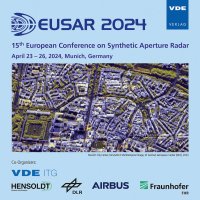Experimental demonstration of L-Band Bistatic Correlation SAR Tomography of Forested Areas: results from the TomoSense campaign
Konferenz: EUSAR 2024 - 15th European Conference on Synthetic Aperture Radar
23.04.2024-26.04.2024 in Munich, Germany
Tagungsband: EUSAR 2024
Seiten: 6Sprache: EnglischTyp: PDF
Autoren:
Tebaldini, Stefano; Mariotti d’Alessandro, Mauro; Salvaterra, Francesco
Inhalt:
In the context of spaceborne Synthetic Aperture Radar (SAR) remote sensing, the term bistatic correlation tomography refers to a 3D imaging technique based on processing interferometric pairs acquired within a single pass of two satellites flown in close formation. In so-doing, the processed data are inherently unaffected by temporal decorrelation, thus enabling 3D imaging of decorrelating targets such as forested areas. This work presents an experimental demonstration of this concept using bistatic airborne data from the ESA campaign TomoSense, flown by MetaSensing in 2020 at the Kermeter area in the Eifel Park, North-West Germany. The data-set includes L-band surveys acquired by simultaneously flying two aircraft to gather bistatic data along different trajectories. Three 3D representations of the Kermeter forest are generated by processing repeat-pass mono- and bistatic data via back-projection, and by using correlation tomography to process interferograms between mono- and bi-static images acquired in the same pass. Despite the presence of bistatic baselines much larger than planned, the results from correlation tomography are found in very good agreement with those from traditional repeat-pass tomography, therefore providing experimental evidence in support of the feasibility of this technique in the context of future L-Band bistatic spaceborne missions.


